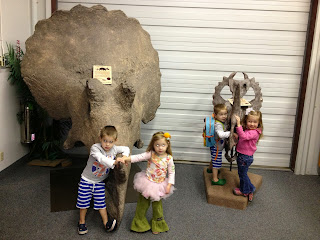Some Fun Facts: This museum was built in 1976 to display the collection of Dr. James A. Jensen and his crews. Over many years, Dr. Jensen has collected fossils and dinosaur bones from Utah, Colorado, Wyoming, and Montana. Many of the fossil were kept in unprepared molds and housed under the BYU Cougar Stadium until they found a home in the museum. The museum has
many fossils from the Jurassic Period (210-140 million years ago) and is one of the
top five collections from this period in the world. See this link to learn more about the museum: BYU Museum of Paleontology
We learned that a Dinosaur Hunter is called a Paleontologist*. He/she sometimes wears a hard hat, jacket, and works with tools at his/her job.
We also saw a simple pictorial definition of a dinosaur and plant fossil*: a dead dinosaur and an old tree had fallen into mud. Mud covered the dino and tree. Layers formed over the bones over the years and then wind and water erode the earth and the dino and plant are uncovered and found again as fossils.
We learned and then guessed what a dinosaur may have eaten according to the type of teeth it has. Sharp teeth are for ripping meat and are called Carnivores. Flat, wide teeth are for grinding and chewing plants and are called Herbivores.
We saw dinosaurs that swam in the sea, walked on land, and flew in the sky. Come and see some of what we saw!


We learned that a Dinosaur Hunter is called a Paleontologist*. He/she sometimes wears a hard hat, jacket, and works with tools at his/her job.
We also saw a simple pictorial definition of a dinosaur and plant fossil*: a dead dinosaur and an old tree had fallen into mud. Mud covered the dino and tree. Layers formed over the bones over the years and then wind and water erode the earth and the dino and plant are uncovered and found again as fossils.
We learned and then guessed what a dinosaur may have eaten according to the type of teeth it has. Sharp teeth are for ripping meat and are called Carnivores. Flat, wide teeth are for grinding and chewing plants and are called Herbivores.
We saw dinosaurs that swam in the sea, walked on land, and flew in the sky. Come and see some of what we saw!


Example of a dinosaur fossil
A favorite mural of various dinosaurs as they may have lived and roamed.
The children are all sitting on a replica of an Dinosaur thigh (Apatosaurus femur) bone.
We have our dinosaur faces on.


Some dinosaur skeletons are quite small (like the one in the box) and are overshadowed by sharped toothed larger dinosaurs!

We have our dinosaur faces on.


Some dinosaur skeletons are quite small (like the one in the box) and are overshadowed by sharped toothed larger dinosaurs!

Our legs look small compared to this dinosaur


Armor Plates protected some dinosaurs, called scutes.



This Triceratops "Three horned face"was a flat toothed (plant eater, herbivore) with armour that may have helped defend it against a T-Rex.





Armor Plates protected some dinosaurs, called scutes.



This Triceratops "Three horned face"was a flat toothed (plant eater, herbivore) with armour that may have helped defend it against a T-Rex.



There were many places to touch and feel.
This is a petrified turtle shell.
We went to the restroom, washed our hands, and
enjoyed a snack back at school
Paleontology:Paleontology is the study of the fossil forms of all life, animals and plants.
Paleontologist: "Dinosaur Hunter;" A person who studies about fossils and the life of animals and plants as left by their bones.
Fossil: Plants or animals that become stuck in the mud, die, are covered with earth, uncovered years later and found. "Fossils are the naturally preserved remains or traces of ancient life that lived in the geological past.
Carnivore: Sharp toothed "meat eaters." Example would be a Tyrannosaurus Rex
Herbivore: Flat or ridged toothed "plant eaters" that grind and crush the foods they eat. Example from the museum the Great Ground Sloth.
Omnivore: An animal that eats both plants and animals (sharp and flat teeth).
Special Thanks to Mrs. DeGraff, Mrs. Scoville, Miss Nikki, and Mr. and Mrs. Stowe for driving and accompany us on this fun day and to Dade for fun snacks: cheese crackers, fruit leather, fruit snacks, and BONE candies!



Back at school, we had a "run around"recess outside and then worked on cutting out our and gluing our D the Dinosaur.

Dade said, "I did it! I cut it out all by myself!"









